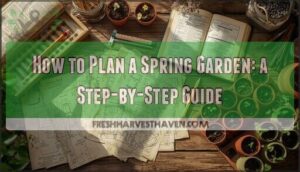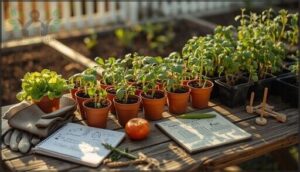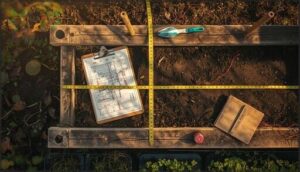This site is supported by our readers. We may earn a commission, at no cost to you, if you purchase through links.
The difference between a thriving spring garden and a disappointing one often comes down to decisions made in winter. Learning how to plan a spring garden isn’t about complicated techniques—it’s about asking the right questions at the right time.
While your neighbors are still scrolling through seed catalogs in March, experienced gardeners have already mapped their beds, tested their soil, and scheduled their succession plantings. Your frost date determines when seeds go in the ground. Your zone dictates which varieties will survive. Your layout affects everything from pest pressure to harvest timing.
Get these foundation pieces right in January or February, and you’ll be harvesting crisp lettuce and sweet peas while others are just breaking ground.
Table Of Contents
- Key Takeaways
- When Should You Start Planning a Spring Garden?
- How to Choose The Right Plants for Spring
- Designing Your Spring Garden Layout
- Preparing Garden Beds and Materials
- Creating a Planting and Maintenance Schedule
- Frequently Asked Questions (FAQs)
- What companion plants work best together?
- How do you protect seedlings from pests?
- When should you start hardening off seedlings?
- What are the best organic fertilizers for spring?
- How do you manage garden watering schedules?
- How do I protect seedlings from late frosts?
- What watering schedule works best for spring gardens?
- How can I prevent common spring garden pests?
- Should I use mulch in my spring garden?
- When should I thin out overcrowded seedlings?
- Conclusion
Key Takeaways
- Start planning your spring garden in winter—well before the ground thaws—so you can test soil, order seeds, and map beds based on your USDA hardiness zone and last frost date.
- Choose crops that match your climate and eating habits, focusing on cool-season vegetables like lettuce and peas that tolerate light frost, and disease-resistant varieties that reduce losses.
- Design your garden layout with 3–4 foot wide beds for easy reach, group plants by water needs and sun requirements, and use proper spacing to prevent crowding and disease.
- Create a planting schedule by working backward from your frost date, start seeds indoors 4–10 weeks early, and use succession planting every 7–14 days to extend your harvest window.
When Should You Start Planning a Spring Garden?
The best time to start planning your spring garden is winter, well before the ground thaws. This gives you a chance to organize seeds, order supplies, and figure out what works for your specific location.
Three key factors will shape your timeline: understanding your gardening zone, pinpointing your last frost date, and learning from what worked—or didn’t—in seasons past.
Identifying Your Gardening Zone
Why does your location matter so much? Your hardiness zone tells you which plants will survive winter in your local climate. The USDA map divides the country into zones based on average minimum temperatures. The new USDA map includes temperature data from over 13,000 weather stations.
Here’s what you need to know:
- Enter your ZIP code on the USDA map website
- Check if climate change shifted your zone warmer
- Note microclimates in your yard
- Match plants to your zone number
- Consider both zone determination and frost dates for plant survival
Determining Your Last Spring Frost Date
Knowing your zone sets the stage, but your local frost date tells you when it’s safe to plant. The last spring frost date marks the median date of the final 32°F dip for your area, calculated from 30 years of weather records.
Here’s how frost dates vary by climate zone:
| Zone | Last Frost Range | Example City |
|---|---|---|
| Zone 5 | April 7–30 | Chicago (April 12) |
| Zone 6 | April 1–21 | Boston (April 6) |
| Zone 7 | March 22–April 3 | Atlanta (March 17) |
Frost date tools let you enter your ZIP code for probability-based dates. Some tools show 10%, 30%, and 50% thresholds—meaning there’s a 10% chance frost strikes after the early date and a 50% chance after the median.
City examples reveal zone variability. Denver sits in Zone 5 but faces frost risk until April 30 due to elevation, while Seattle’s marine climate brings an April 6 last frost despite its northern latitude.
Climate change has shifted many frost dates earlier, lengthening growing seasons in parts of the Midwest and beyond. Even so, individual years can still bring late cold snaps.
Always add a safety buffer of one to two weeks after your published frost date before planting tender crops. This simple step drops your frost risk to near zero in most years. Cross-check national charts with local airport data, since urban heat islands can push frost dates a week earlier than surrounding areas. Real-time frost alerts help you respond when late freezes threaten, even after the statistical last frost date has passed. Remember that hardiness zones are determined by average annual minimum temperatures.
Reviewing Previous Garden Performance
Your frost date sets the timeline, but your past results tell you what to fix. Pull out last year’s gardening journal and review yield analysis, pest problems, and crop failures. Check where soil issues limited growth and which harvest times worked best.
A soil test reveals pH shifts since last season. Record lessons learned—maybe tomatoes struggled in that shady corner, or aphids overwhelmed your kale. These notes shape smarter crop rotation and plant choices, turning past mistakes into this spring’s wins.
How to Choose The Right Plants for Spring
Picking the right plants for your spring garden sets you up for a season of healthy growth and rewarding harvests. You’ll want to think about timing, temperature needs, and what actually makes sense for your space and eating habits.
Let’s break down the key factors that’ll help you make smart choices from the start.
Cool-Season Vs. Warm-Season Crops
Your crop selection shapes your entire spring garden plan. Cool season crops thrive between 55°F and 75°F, tolerate light frosts down to 25°F, and include broccoli, lettuce, and peas. Warm season crops need 65°F to 95°F, can’t handle frost below 32°F, and include tomatoes, peppers, and cucumbers.
Temperature tolerance and frost resistance determine your planting windows and growing cycles.
Selecting Perennials, Annuals, and Flowers
Your flower garden balances long-term value with seasonal color. Perennials like echinacea, salvia, and hosta return year after year with lower maintenance needs, blooming for two to eight weeks.
Annuals such as petunias and impatiens deliver continuous color all season, supporting pollinator attraction with bloom times you can control.
Consider your regional preferences, color palettes, and maintenance needs when selecting spring flowers for planting.
Choosing Disease-Resistant and Bolt-Resistant Varieties
When choosing crops for spring, seek out vegetable varieties bred for disease resistance and bolt resistance—these traits protect your harvest from common setbacks. Cornell Cooperative Extension and seed catalogs list resistance codes: look for cucumber lines such as ‘Spacemaster 80’ that resist multiple blights, and lettuce like ‘Nevada,’ which withstood summer heat in university trials without bolting.
Integrating resistance planning now means fewer losses later.
Only Growing What You’ll Eat
Waste is the silent thief of garden potential—and you have the power to stop it. Planning your spring garden around what your household actually eats transforms effort into nourishment, not compost. To reduce food waste and get the most out of garden yield, follow this efficient garden planning approach:
Plan your spring garden around what you’ll actually eat—effort becomes nourishment, not waste
- Track consumption habits to guide crop selection in your vegetable garden
- Plan crop preferences before finalizing your planting schedule
- Focus harvesting on high-use items throughout the season
Designing Your Spring Garden Layout
A well-thought-out layout turns your spring garden from a random collection of plants into a productive, beautiful space. Before you start digging or ordering seeds, you need to understand your garden’s dimensions, sun patterns, and how different plants will work together.
Let’s walk through the steps to design a layout that optimizes your space and sets you up for a successful growing season.
Measuring and Mapping Garden Space
Think of matching your garden to your space as drawing a treasure map—every measurement matters. Grab a tape measure and record your plot dimensions: length, width, and depth if you’re building raised beds. Note obstacles like posts or rocks, then mark sun and shade zones at different times of day. A simple garden map helps you see what fits where before you plant anything.
| Garden Feature | What to Record |
|---|---|
| Bed Dimensions | Length, width, depth (12–18 inches typical) |
| Sun Exposure | Morning, midday, afternoon patterns |
| Slope and Drainage | High spots, low spots, water flow direction |
| Obstacles | Trees, posts, utility lines, structures |
Planning your garden layout with scale accuracy—like one inch equals one foot on paper—lets you arrange beds, paths, and planting zones without guesswork. This garden layout becomes your blueprint for a productive spring.
Using Grid Paper or Digital Planners
You’ll find that grid paper benefits include precise scaling—often one square equals one foot—while digital planner features offer preloaded plant data and timelines.
An accuracy comparison shows digital tools excel at spacing, but a hybrid approach works best: sketch your spring garden plan on paper, then track planting garden layout details digitally.
Don’t forget data backup for either method.
Planning Beds, Paths, and Plant Groupings
Garden beds that measure 3–4 feet wide let you reach the center without stepping on soil, keeping it loose and healthy. Paths should be at least 12–18 inches wide—wider if you’ll use a wheelbarrow.
Group plants by water needs and root depth so irrigation stays efficient.
Permanent bed dimensions reduce compaction, boost soil health, and make weeding from paths simple and organized.
Considering Sun, Shade, and Plant Spacing
Once your beds and paths are set, sun mapping and shade analysis will shape which crops go where. Full sun plants need 6–8 hours of direct light, while leafy greens tolerate partial shade with 4–6 hours.
Proper plant spacing and plant density prevent crowding that blocks light interception. For vertical gardening with trellised crops, allow 24–36 inches between plants to optimize airflow and yield in your garden layout.
Preparing Garden Beds and Materials
Getting your garden beds ready now will save you time and headaches later when planting season arrives. This means tackling a few essential tasks that set the stage for healthy growth throughout the spring and summer.
Let’s walk through the key steps to prepare your beds, refresh your supplies, and make sure you’re ready to plant.
Clearing Debris and Old Growth
Before planting, you’ll want to clear last year’s leaves, stems, and plant debris from your garden beds. Removing old growth helps prevent disease carryover and pest overwintering while reducing the weed seedbank.
Cleaning up garden beds also allows soil to warm faster in spring, giving your new plants a head start. Just wear gloves and long sleeves—disturbing damp debris can release mold spores and create injury risks.
Composting and Fertilizing Techniques
Once the beds are clean, it’s time to rebuild the soil. Spread a two- to three-inch layer of compost in early spring and work it into the top six to eight inches. This boosts soil nutrients and organic matter right when roots need it most.
If you’re using manure, incorporate it at least two weeks before planting to reduce pathogen risk and let nutrients integrate safely.
Checking Tools, Supplies, and Seed Inventory
Before planting begins, take stock of what you have. Clean shovels, rakes, and pruners with soap and a stiff brush, then sharpen and oil any moving parts.
Inspect seed packets for expiration dates—onion seeds last just one year, while tomatoes stay viable up to four. Test older seeds by placing ten on a damp paper towel; if fewer than five sprout, order fresh ones.
Creating a Planting and Maintenance Schedule
A good schedule keeps your spring garden on track from seed to harvest. You’ll need to know when to start seeds indoors, when to transplant seedlings outside, and how to time your plantings for a steady supply of fresh produce.
Let’s walk through the steps to create a planting and maintenance calendar that takes the guesswork out of garden timing.
Using Seed Packets and Planting Calendars
Your seed packets hold all the timing clues you need. Check the “days to maturity” to count backward from your frost dates, then note planting depth and germination windows.
Enter these details into a planting calendar—digital calendars work great for setting reminders. This approach turns seed viability data and maturity days into a practical planting schedule that keeps your seed starting on track.
Scheduling Indoor Starts and Direct Sowing
Once you’ve noted your frost date, work backward to schedule indoor sowing—most vegetables need four to ten weeks indoors before transplanting seedlings outside. Cool-season crops start earliest, often eight to ten weeks before your last frost.
Direct sowing waits for soil temperature needs and photoperiod effects to align. Germination durations vary by crop, so stagger planting time to smooth your outdoor shift.
Crop Rotation and Succession Planting
To keep soil healthy and harvests steady, rotate each vegetable family through your beds every three to four years—this pest management tactic disrupts disease cycles and improves soil health. Pair crop rotation with succession planting to extend your harvest:
- Sow lettuce or greens every seven days
- Stagger beans and corn at ten-day intervals
- Plant cucumbers every three weeks
Cover crops between seasons rebuild nutrients and protect soil.
Early Spring Maintenance and Pruning Tasks
Before buds swell, tackle Dormant Pruning on fruit trees and summer-blooming shrubs—late winter cuts stimulate vigorous growth and improve flowering.
Clear debris and dead foliage for Bed Cleanup and Disease Prevention, then edge borders to ready beds for mulch. Early Weed Control stops competition before transplants go in.
Sharpen shears and inspect hoses now; Tool Maintenance and preparing the garden for spring equipment checks save time when planting kicks off.
Tracking Progress With a Garden Journal
A simple notebook becomes your secret weapon for planning a spring garden year after year. Record planting dates, growth patterns, and pest monitoring observations weekly—varieties that germinate 7–14 days faster than packet estimates matter.
Log yield data and harvest spans to rank which crops deliver. Those rotation planning notes prevent disease buildup and guide next season’s spring garden plan with real evidence, not guesswork.
Frequently Asked Questions (FAQs)
What companion plants work best together?
Tomato companions like basil can boost yields by 20%, while marigolds cut whitefly settling by over 75%.
Pair brassicas with thyme or nasturtium to reduce caterpillar damage, and plant the Three Sisters guild for mutual soil enhancement.
How do you protect seedlings from pests?
You can shield seedlings with physical barriers like cloches or insect netting, apply seed treatments for disease resistance, use biological control methods, and set up monitoring traps to catch garden pests early.
When should you start hardening off seedlings?
You should start hardening off seedlings about 7–14 days before your last spring frost date for warm-season crops, gradually increasing outdoor exposure to reduce transplant shock and strengthen plant physiology.
What are the best organic fertilizers for spring?
Compost benefits your soil with steady nutrients, while worm castings boost yields dramatically.
Bone meal aids roots, blood meal fuels leafy growth, and fish emulsion delivers nitrogen-rich nourishment.
Organic fertilizer choices depend on your plants’ needs.
How do you manage garden watering schedules?
You can manage garden watering schedules by checking soil moisture regularly, using drip irrigation methods, applying mulch benefits to reduce evaporation, and adjusting watering techniques based on evapotranspiration rates and specific crop water needs.
How do I protect seedlings from late frosts?
You’ll want to drape row covers or frost cloth over garden hoops when cold weather threatens. Mulch application around stems adds extra insulation, while cloches and cold frames create warm pockets that shield tender seedlings from frost damage.
What watering schedule works best for spring gardens?
Think of water as the lifeblood of your spring garden. Most crops need 1–2 inches weekly, delivered once or twice deeply in early morning, adjusted for your soil type and plant stage.
How can I prevent common spring garden pests?
Preventing spring garden pests starts with garden sanitation—remove old debris and weeds.
Use row covers over seedlings, encourage beneficial insects like ladybirds, and apply organic controls such as neem when needed.
Should I use mulch in my spring garden?
Mulch acts like a warm blanket for your spring garden beds, locking in moisture and keeping weeds at bay.
It moderates soil temperature, boosts soil health with organic matter, and makes soil preparation easier year-round.
When should I thin out overcrowded seedlings?
Thin seedlings once they develop their first set of true leaves, usually 10 to 20 days after germination. Space them about 5 cm apart initially, preventing root tangling and competition for light.
Conclusion
Think of your garden plan as the blueprint for a spring orchestra—each seed, bed, and schedule playing its part in harmony. When you know how to plan a spring garden, you’re not just growing plants, you’re shaping a thriving ecosystem adapted to your space and needs.
Careful choices now set the stage for crisp harvests and vibrant blooms. With your groundwork complete, you’re ready to watch your garden come alive, one well-planned step after another.
- https://planthardiness.ars.usda.gov/home
- https://www.gardendesign.com/how-to/frost-date.html
- https://extension.umd.edu/resource/spring-frost-or-freeze-dates-maryland
- https://bonnieplants.com/blogs/garden-fundamentals/first-and-last-frost-dates
- https://piedmontmastergardeners.org/article/organic-matter-the-gardeners-silver-bullet/











